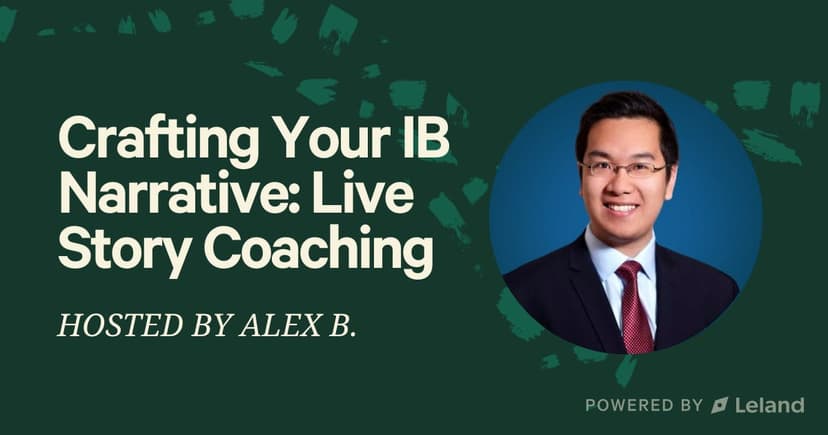Investment Banking Interview Guide: Process & Tips (2025)
Everything you need to know to ace the investment banking interview process, including tips for landing an interview and acing the qualitative and quantitative portions, written by a Credit Suisse investment banker.
Posted October 25, 2025

Join a free event
Learn from top coaches and industry experts in live, interactive sessions you can join for free.
Table of Contents
This investment banking interview guide is designed for candidates who want to stand out in investment banking interviews and secure offers at top firms. It explains the interview process, covers technical concepts, and provides tactics for behavioral questions. By reviewing these sections, applicants gain the technical knowledge and communication skills needed to handle questions and answers successfully.
What is Investment banking?
Investment banking continues to attract professionals with backgrounds in finance, accounting, economics, engineering, and other fields. The role involves advising companies on mergers, acquisitions, leveraged buyout transactions, debt capital markets deals, and initial public offerings, all of which are key functions of an investment bank. Employers look for candidates who grasp corporate finance, valuation, and the three financial statements. Candidates also need strong communication skills to interact with colleagues and clients in high-pressure settings.
Reading this investment banking interview guide helps applicants develop a competitive edge by learning how to handle investment banking interview questions, whether they are technical questions or behavioral prompts. The recruiting process rewards those who are prepared, confident, and well-informed about key technical topics like discounted cash flow analysis, net present value, enterprise value, equity value, and more.
Read: What is Investment Banking?
Overview of the Investment Banking Recruiting Process
The investment banking recruiting process is competitive and involves multiple rounds of interviews. The goal is to secure an interview, pass all screening steps, and ultimately convert your Superday into an offer. Below is a step-by-step breakdown of the process to help you prepare effectively.
Step 1: Networking and Outreach
Building Your Network
The first and most important step is networking. This is where you’ll begin building valuable relationships with people in the investment banking industry. Connecting with professionals, especially through alumni, LinkedIn, and events, is essential for gaining insight and learning about the recruiting process. Attending private equity and sell-side focused panels or virtual events can also help you get direct access to industry professionals.
Targeting the Right Firms
It’s critical to research firms before reaching out. You should target firms based on their group focus (e.g., M&A, capital markets) and the industry they specialize in (e.g., healthcare, technology). Tailor your outreach to match their culture and recruiting process.
Avoiding Common Mistakes
A common mistake is directly asking for a job in your initial message. Instead, focus on asking for insight into the industry, the firm, and advice on how to prepare for the recruiting process. This approach helps you build a rapport and shows your genuine interest.
Step 2: Application Process
Resume Submission
Once you’ve networked, it’s time to apply. Submit your resume, along with a deal sheet if applicable. Your resume should highlight your finance, accounting, and research skills. Be concise and focus on measurable accomplishments that demonstrate your analytical ability.
Importance of Referrals
Having referrals ready before the application deadline can give you a significant advantage. Referrals from people you’ve networked with within the firm show that others believe in your potential, and this can move your application to the top of the pile.
Application Deadlines
Avoid waiting until the last minute to submit your application. Planning ahead is essential to ensure that everything is submitted on time and accurately. Keep track of deadlines and ensure your materials are in before the clock runs out.
Step 3: First-Round Investment Banking Interview
The Structure of the Interview
The first-round interview is typically 30-45 minutes long and involves both behavioral and technical questions. You may meet with an interviewer or a panel of bankers who will assess your overall fit and basic technical knowledge.
Behavioral Questions
Expect behavioral questions such as:
- "Why investment banking?"
- "Walk me through your resume."
- "What excites you about this firm?"
These questions are designed to test your motivations and whether your experience aligns with the role. Be prepared to talk clearly about your background and why you're interested in a career in investment banking.
Technical Questions
You will also likely face basic technical questions that assess your understanding of financial statements, valuation, and basic accounting concepts. Common questions include:
- "What are the three financial statements?"
- "Can you explain the concept of enterprise value?"
It’s important to prepare for these by revising accounting principles and basic valuation techniques.
Step 4: Superday / Assessment Center
Overview of Superday
The Superday is the final round of interviews, where candidates face a series of back-to-back interviews. These sessions often include analysts, associates, VPs, and MDs. This stage evaluates both your technical skills and your ability to work under pressure.
Group Case Studies
During Superday, expect to participate in group case studies. These are designed to assess how well you can collaborate and solve problems as a team under tight deadlines. Banks will evaluate your communication skills, problem-solving approach, and how you handle conflict or disagreement within the group.
Written Excel Task
An Excel task is also a common component, where you may need to build or manipulate a financial model. Be prepared to demonstrate your financial modeling skills, such as DCF or LBO modeling, under time constraints. This is your opportunity to showcase your Excel proficiency and your understanding of key valuation concepts.
Markets and Deal Discussions
Expect to discuss current market trends and recent deals. Be prepared to talk about sectors of interest and show you have been actively following the industry. Being able to speak intelligently about private equity, capital markets, or recent M&A deals will give you an edge.
Culture Fit Assessment
Aside from your technical skills, Superday is also an opportunity to assess cultural fit. The firm will want to determine if your personality and values align with theirs. Expect questions that assess your teamwork, adaptability, and ability to work under pressure.
Read: Investment Banking Analysis: Financial Valuation for IB Interviews – A Beginner's Guide
What Banks Expect During Superday
At Superday, banks are looking for candidates who exhibit the following:
- Clear Thinking: Can you stay calm and make decisions in high-pressure situations?
- Correct Concepts: Do you understand core technical concepts like enterprise value, DCF, and LBO modeling?
- Structured Process: Can you approach complex problems methodically?
- Calm Delivery: How well do you communicate your thoughts and ideas under pressure?
Note: Your ability to remain composed, apply technical concepts accurately, and demonstrate a clean process will play a huge role in securing an offer.
The Four Categories of Investment Banking Interview Questions
1. Story – Your Path and Preparation
This category focuses on understanding your background, motivation, and why you're pursuing a career in investment banking. Expect to answer questions like:
- “Why investment banking?”
- “Walk me through your resume.”
- “What motivates you to work in this industry?”
These questions assess whether your experience aligns with the job and whether you're genuinely interested in investment banking. It’s important to structure your answers in a clear and concise way that highlights your relevant experiences and motivations.
Expert Tip: Focus on key milestones in your journey and be able to explain how each step has prepared you for this role. Avoid generic answers; make it specific and personal.
2. Fit – Teamwork, Leadership, Ownership, and Handling Challenges
Fit questions are used to assess your interpersonal skills and how well you’ll integrate into the team. Common questions include:
- “Tell me about a time when you worked with a difficult teammate.”
- “How do you handle conflicts in a team setting?”
- “What’s your greatest strength and weakness?”
Banks are looking for candidates who can collaborate effectively, demonstrate leadership, and show ownership over their work. It's not just about being a good technical fit; banks want people who can thrive in high-pressure environments and work well in teams.
Expert Tip: Use the STAR method (Situation, Task, Action, Result) to structure your answers to behavioral questions. Be ready with 3–4 solid examples of teamwork, leadership, and overcoming challenges. Tailor these stories to demonstrate skills relevant to investment banking, such as decision-making, resilience, and effective communication.
Read: Time Management in Investment Banking Interviews: How to Prioritize Your Answers
3. Deals, Markets, and Companies – Relevant Deal, Sector Price Drivers, and Company Insights
In this category, expect questions about the broader market and recent deals or companies you're interested in. Interviewers will want to know:
- “Tell me about a recent deal you followed.”
- “What are the key price drivers in the [industry] sector?”
- “What makes [company] a good investment?”
This section tests your market knowledge and whether you're actively following developments in the industry. Banks want candidates who can discuss deals, market trends, and company valuations with confidence. You should be prepared to speak about relevant transactions, price drivers, and how different sectors are performing.
Expert Tip: Keep track of recent M&A deals, IPOs, and private equity transactions. Being able to analyze a deal from start to finish and understand its financial drivers will help you stand out.
4. Technical – Financial Statements, Valuation, Enterprise Value, LBO Modeling, and Excel Math
Technical questions will make up a significant portion of your interview. This category will assess your knowledge of finance, accounting, and financial modeling. You can expect questions such as:
- “Walk me through the three financial statements.”
- “What is the difference between enterprise value and equity value?”
- “How would you value a company with negative cash flows?”
- “Walk me through a basic LBO modeling scenario.”
These questions are designed to test your technical understanding and ability to apply financial concepts to real-world situations. Interviewers want to see if you can explain complex topics clearly, whether it's calculating valuation, interpreting financial statements, or solving for enterprise value.
Expert Tip: Make sure you're comfortable with key technical concepts like discounted cash flow analysis (DCF), LBO models, and the relationships between the three financial statements. Practice with Excel to refine your financial modeling skills.
Mastering Technical Questions
Financial Statements
Understanding how the three primary financial statements, the Income Statement, Balance Sheet, and Cash Flow Statement, interact is vital in investment banking interviews.
Linkages Between the Financial Statements
The Income Statement shows net income, which flows into retained earnings on the Balance Sheet. The Cash Flow Statement starts with net income and adjusts for changes in working capital and non-cash items like depreciation, bridging accrual accounting to cash.
For instance, if inventory increases, cash decreases on the Cash Flow Statement. This is reflected as an increase in inventory on the Balance Sheet, and a write-down of inventory lowers net income on the Income Statement, but it is added back on the Cash Flow Statement because it's a non-cash expense.
Capex and Depreciation
Capex shows up in cash flow from investing activities (CFI) and reduces cash. On the Balance Sheet, it adds to property, plant, and equipment (PP&E). Depreciation and amortization (D&A) reduce net income on the Income Statement but are added back on the Cash Flow Statement since they don't impact cash.
Working Capital
Working capital is the difference between current assets and current liabilities. Changes in working capital affect free cash flow. For example, an increase in accounts receivable (AR) uses cash, while an increase in accounts payable (AP) provides cash.
Valuation Methods
Valuation methods are core to investment banking interviews, and understanding how to apply these methods is critical.
Discounted Cash Flow (DCF) Analysis
DCF projects a company’s future free cash flows (FCF) and discounts them using the weighted average cost of capital (WACC). The final year’s value is typically calculated using a terminal value (either through the Gordon Growth method or the exit multiple method). The output of a DCF analysis is enterprise value.
Key Risks: The biggest risks in DCF are the assumptions about terminal growth and WACC, which can significantly impact the valuation.
Public Comparables (Public Comps)
Public comps compare a company to similar publicly traded companies using multiples such as EV/EBITDA and P/E ratio. The output from this method is a range of enterprise values or equity values.
Key Risks: The main risk with public comps is choosing an inappropriate peer set, which can distort the valuation.
Precedent Transactions
Precedent transactions look at past deals involving similar companies. This method uses deal multiples and control premiums to calculate enterprise value and equity value.
Key Risks: The risk here is relying on old market data that may not accurately reflect current conditions.
Enterprise Value vs. Equity Value
Enterprise value (EV) reflects the total value of a firm, including debt, preferred stock, and minority interest, minus cash. Equity value represents the portion of the firm owned by common shareholders. In an acquisition, the buyer typically sets a purchase price for the equity and then assumes or refinances the debt to determine enterprise value. Equity value only reflects the value attributable to shareholders, while enterprise value includes all capital providers.
LBO Modeling Basics
In a Leveraged Buyout (LBO), a private equity firm acquires a company using a combination of debt and equity. The goal is to generate high returns on the equity portion by leveraging the company’s assets. Key drivers of an LBO include entry multiple, debt paydown, EBITDA growth, and exit multiple. What interviewers expect is your ability to understand the basic structure of the deal, how the sources and uses of funds are allocated, how to calculate leverage ratios, and how IRR is impacted by these factors.
Excel & Financial Modeling Skills
Excel and financial modeling skills are crucial in investment banking. You’ll likely be asked to build models such as a 3-statement model, DCF, or LBO. To prepare, you should practice keyboard shortcuts, error checks, and sanity checks to ensure accuracy. You’ll also need to be comfortable with Excel tools like circularity control and data validation. Building a solid financial model requires proficiency in both conceptual understanding and practical application.
Preparing for Deal and Market Questions
In investment banking interviews, it's essential to prepare for questions about deals, markets, and companies. These questions assess your ability to analyze a company's financials, understand market trends, and evaluate a deal’s rationale. Here's how you can structure your approach and respond effectively.
How to Research a Company, Market, and Deal
To prepare for these questions, you need to quickly analyze a company, its market, and recent transactions. Break your research down into manageable sections to ensure a solid understanding in a short amount of time.
10-Minute Company Scan
Begin with a quick scan of the company. Understand its business model, how it generates revenue, and its core operations. Assess its revenue segmentation. How much revenue does each segment contribute? Evaluate its margin trends and determine whether they have been improving or declining over time. Understand its leverage and whether the company is heavily reliant on debt. Finally, assess its cash flow and ability to sustain operations and growth.
Market Drivers
Next, evaluate the broader market the company operates in. Key factors to consider include unit growth, which shows how the company’s market is expanding. Pricing power is another important consideration. Does the company have the ability to increase prices without losing customers? Regulation plays a critical role, so it’s important to understand any regulatory risks or benefits impacting the company. Finally, examine input price swings, such as changes in the costs of raw materials, as this can influence the company's profitability.
Deal Frame
When reviewing a deal, focus on several important aspects. Start by identifying the buyer and the seller, and highlight the enterprise value (EV) to EBITDA multiple paid. This gives you insight into how the market valued the target. Understand the purchase rationale behind the deal. Why did the buyer pursue this acquisition? Was it a strategic or financial decision? Clarify whether the transaction was a buy-side or sell-side deal, and briefly mention any risks involved.
Discussing a Relevant Deal (Simple Script)
Discussing a deal in an investment banking interview requires clear and structured communication. Below is a breakdown of how to approach a relevant deal discussion, step-by-step.
1. One-Line Summary
Start by providing a brief overview of the deal in a single sentence. This should capture the essential details and highlight the key figures. For example:
- "Company X, a leading software provider, was acquired by Company Y for $X billion, at an EV/EBITDA multiple of X."
Note: This summary sets the stage and gives the interviewer an immediate understanding of the deal you're discussing.
2. Deal Specifics: Buyer, Target, and Valuation Multiple
After providing the one-line summary, delve into the specifics of the deal. Focus on:
- The buyer and target: Identify the companies involved and their respective roles in the deal.
- The headline price: Mention the total value of the transaction.
- EV/EBITDA multiple: Discuss the enterprise value to EBITDA multiple used in the deal. Compare this multiple to industry standards to provide context. If the multiple is higher or lower than usual, explain why that might be the case and how it affects the deal’s valuation.
For example, you could explain whether the multiple paid is in line with other companies in the same industry or if it’s significantly higher or lower.
3. Strategic or Financial Logic Behind the Acquisition
Next, explain the rationale behind the acquisition. This could be either strategic or financial:
- Strategic Logic: Did the buyer acquire the company to expand its market share, acquire new technology, or enter a new geographical market?
- Financial Logic: Was it a financial acquisition aimed at generating synergies, reducing costs, or improving efficiency?
For instance, the buyer might have been interested in acquiring technology or expanding its product portfolio, or perhaps it was more about improving operational efficiency and cutting costs.
4. Identifying Risks and Mitigation
Every deal involves risks, and it’s important to show that you can think critically about them. Identify two key risks associated with the deal and suggest ways the buyer could mitigate those risks.
For example:
- Risk 1: Market Competition – If there’s high market competition that could threaten future growth, the buyer could leverage its existing distribution network to drive sales in new regions.
- Risk 2: Regulatory Challenges – If regulatory hurdles could delay the integration or approval process, the buyer might engage with regulators early in the process to smooth over potential obstacles.
Note: Showing that you can assess risks and propose ways to address them demonstrates your practical understanding of how deals unfold.
5. Your View: Fair Valuation or Not?
Finally, give your opinion on whether the deal was a fair valuation. Was the price justified based on the company’s growth prospects and industry trends? Explain your reasoning by referencing the deal's multiple and comparing it to similar transactions in the market.
For example, you could argue that the multiple seems reasonable given the company’s strong future growth projections or that it may be on the higher end due to the strategic nature of the acquisition.
Nailing the Behavioral Interview
Fit Questions Banks Ask
Banks often focus on your motivation for pursuing investment banking and your ability to work in high-stakes, fast-paced environments. Common fit questions you should be ready for include:
Why Investment Banking?
Banks want to know why you are interested in this career path. Your response should demonstrate a genuine understanding of the role and a clear connection between your skills and interests with the demands of the industry. Avoid generic answers and instead focus on specific aspects of investment banking that attract you, such as the opportunity to work on complex transactions, develop financial expertise, or be part of impactful deals.
Why This Group and This Bank?
Interviewers want to understand why you have chosen this specific group within the bank and why the bank itself stands out to you. Research the bank’s culture, values, and recent deals to offer a response that shows you are not just looking for any job in investment banking but are genuinely interested in their specific culture and business focus.
Walk Me Through a Challenging Team Process and What You Changed
Banks value teamwork and problem-solving skills. Be prepared to describe a situation where you were part of a team that faced a challenge. Emphasize the role you played in the process, the actions you took to overcome the challenge, and the results. Interviewers want to know how you navigate difficult team dynamics, how you contribute to the team’s success, and how you handle conflict.
Tell Me About a Mistake and the Preparation You Use Now to Avoid It
Everyone makes mistakes, but how you handle them and learn from them is what matters. In your answer, describe a mistake you made in a previous experience, explain how it impacted the project or team, and, importantly, focus on what you learned from the experience. Be sure to mention how you have adjusted your approach to prevent similar mistakes.
Read: Preparing for Success: Top 10 Questions Asked in Investment Bank Interviews
STAR with Proof
The STAR method is an effective way to answer behavioral questions:
- Situation: Briefly describe the context or challenge you faced.
- Task: Explain what you needed to accomplish.
- Action: Detail the steps you took to address the issue.
- Result: Highlight the outcome, ideally with a measurable achievement.
Example:
- Situation: “Led a three-person team to build a financial model for a client’s M&A transaction.”
- Task: “We needed to complete the model in a week for an internal review meeting.”
- Action: “We divided the work into specific sprints, each focusing on different parts of the model.”
- Result: “This reduced model errors by 80% and ensured timely delivery of the final product.”
Expert Tip: Always include one metric or result to show the impact of your actions. This adds credibility and demonstrates the real-world value you brought to the table.
Culture and Communication
In investment banking, your communication style can play a pivotal role in determining your fit for the team. Banks look for candidates who are direct, calm, and specific, especially in high-pressure situations.
Direct, Calm, Specific
When responding to questions, be clear and concise. Avoid long-winded answers or unnecessary details unless requested. It’s also important to remain calm and composed, especially if you’re faced with a challenging question. Practice speaking confidently about your experiences and answers, even if they involve mistakes or difficult situations.
Short Answers First; Detail Only When Asked
Interviewers often want to hear your answer quickly, especially for situational questions. Give them a succinct response first, then offer more details if they ask for elaboration. This approach keeps the conversation focused and makes it easier for the interviewer to stay engaged.
Own Gaps in Knowledge and Show Your Plan to Prepare
Investment banking is a demanding field, and interviewers know that no one has all the answers. If you don’t know the answer to a question, it’s better to admit it honestly rather than try to bluff your way through. However, show that you are proactive in filling knowledge gaps. Mention how you plan to prepare by taking courses, reading up on industry topics, or consulting with experienced colleagues. This demonstrates that you’re committed to continuous improvement.
Case Studies and Practical Exercises
| Case type | What to expect | How to prepare | What can go wrong |
|---|---|---|---|
| Paper LBO | 10–20 minute math test | Practice debt schedules and IRR math by hand | Wrong sign, missing cash sweep |
| DCF mini-case | Forecast, set WACC, pick terminal method | Build a 5-line FCF and one check on multiples | Terminal growth is too high |
| Comps set | Pick peers, pull multiples | Define industry, size, and region filters | Peer set not relevant |
| Group case | Short article, then present | Assign roles, timebox, and agree on the purchase range | Talking past each other |
Common and Challenging Investment Banking Interview Questions & Sample Answers
Accounting & Financial Statements
How do the three financial statements link?
Sample Answer: The Income Statement shows the company's net income, which flows into retained earnings on the Balance Sheet. The Cash Flow Statement starts with net income and adjusts for non-cash items like depreciation and changes in working capital, bridging accrual accounting to cash. For example, if inventory increases, cash decreases on the Cash Flow Statement, and this is reflected as an increase in inventory on the Balance Sheet.
What is net working capital, and why does it move cash?
Sample Answer: Net Working Capital (NWC) is the difference between current assets and current liabilities. When NWC increases, it indicates the company is investing more in short-term assets like accounts receivable or inventory, which uses cash. Conversely, if NWC decreases, it frees up cash. For instance, if accounts payable increase, it provides cash because the company is delaying payments.
Walk through the inventory write-down impact.
Sample Answer: When inventory is written down, the company records a loss on the Income Statement, which reduces net income. This loss is added back on the Cash Flow Statement since it's a non-cash expense. On the Balance Sheet, the inventory value is reduced, which also lowers working capital.
Valuation & Enterprise Value
EV vs. equity value with a quick example.
Sample Answer: Enterprise Value (EV) is the total value of the company, including debt, preferred stock, and minority interest, minus cash. Equity Value represents the portion of the company available to common shareholders. For example, if a company has $100 million in equity, $50 million in debt, and $10 million in cash, the EV is $140 million ($100M + $50M - $10M).
When does EV/EBITDA fail?
Sample Answer: EV/EBITDA can fail when comparing companies with different capital structures, growth rates, or profit margins. This multiple does not account for differences in debt levels or capital expenditures. For instance, a company with high debt and low EBITDA might be valued similarly to another company but could be at higher financial risk, making EV/EBITDA less useful.
Build a one-page discounted cash flow analysis.
Sample Answer: In a DCF, project the company’s future free cash flows (FCF) for a period of 5-10 years, and discount them using the weighted average cost of capital (WACC). Calculate the terminal value at the end of the forecast period using either the Gordon Growth method or the exit multiple method. The sum of the discounted FCFs and terminal value gives the company’s enterprise value.
LBO Modeling
What makes a strong LBO target?
Sample Answer: A strong LBO target typically has stable cash flows, low capital expenditure needs, and strong market positioning. Companies with high EBITDA and low working capital requirements are ideal, as they can generate enough cash to service the debt used in the acquisition. Additionally, a company with a low entry multiple and room for operational improvements offers high potential returns.
How do debt paydown and EBITDA growth drive returns?
Sample Answer: Debt paydown reduces the company’s debt over time, which increases equity value. EBITDA growth increases the company’s ability to generate cash, which helps pay down debt. Both factors drive IRR by improving the company’s profitability and reducing leverage, ultimately enhancing the equity value in an LBO.
If entry = 10x and exit = 9x, what drives success?
Sample Answer: If the entry multiple is 10x and the exit multiple is 9x, success is driven by increasing EBITDA, reducing debt, or improving operational efficiency. The decline in the multiple can be offset by increasing the company’s EBITDA or paying down the debt, which enhances the equity value despite the lower exit multiple.
Deals, Markets, and Companies
Walk me through a deal our group worked on.
Sample Answer: "Company X, a leading software provider, was acquired by Company Y for $X billion at an EV/EBITDA multiple of X. The deal was strategic for Company Y, as it allowed them to expand their product offering and enter new markets. The main risks included regulatory approval and integration challenges, but these were mitigated by early engagement with regulators and a detailed integration plan. I believe the valuation was fair given the target’s strong growth prospects and strategic value to the buyer."
What market risks matter for this industry?
Sample Answer: Market risks in the technology industry include regulatory changes regarding data privacy and competition, fluctuations in input costs for hardware production, and shifts in consumer demand. For instance, changes in data protection laws, such as GDPR, could create regulatory hurdles that delay product launches and impact profitability.
Pick a security and explain why its price moved last week.
Sample Answer: "The price of Company X's stock increased by 5% last week after it reported better-than-expected earnings. The company showed a 10% growth in revenue and announced a strategic acquisition that will help expand its presence in Asia. This news drove investor optimism, causing the stock to rise."
Behavioral Questions
A time you were blocked and how you moved forward.
Sample Answer: "During a team project, we hit a roadblock when one of our team members failed to deliver their part on time. Instead of dwelling on the issue, I reassigned the tasks and took over part of the work myself. I communicated openly with the team to make sure everyone was aligned, and we were able to finish the project on time."
A mistake you made and the change you made.
Sample Answer: "In a previous internship, I missed an important deadline because I underestimated the time required for research. I took ownership of the mistake, communicated it to my supervisor, and worked overtime to complete the task. Since then, I’ve been more diligent with my time management and always build in extra time for unforeseen delays."
Why investment banking over private equity at the beginning of your career?
Sample Answer: "I chose investment banking over private equity because I wanted to develop a strong foundation in corporate finance and deal execution. Investment banking offers the opportunity to work on a wide variety of high-profile transactions, and I felt that this would provide me with the most exposure and learning early in my career."
Read: 20 Most Common Investment Banking Behavioral Questions
Resources and Courses to Prepare
Financial Modeling Course
A comprehensive financial modeling course is essential for mastering core concepts such as 3-statement modeling, DCF, M&A, and LBO. The best courses offer Excel files that allow you to practice building real-world financial models, preparing you for technical questions.
Bank and Industry Primers
Study bank primers and IPO prospectuses to understand the structure of deals and security terms. These documents give you insights into how investment banks operate and how transactions are structured, which will help you during interview discussions on deal specifics.
Equity Research Reports
Equity research reports provide valuable market insight and help you understand sector drivers. By reading these reports, you can gain a deeper understanding of how market trends influence company valuations, preparing you to answer questions related to industry knowledge and deal specifics.
SEC Filings
SEC filings, including 10-K and 10-Q reports, provide in-depth details about the company's debt, covenants, and cash flow. Reviewing these filings will improve your understanding of real-world financials, key metrics, and industry standards, which are often covered in technical interview questions.
Final Preparation Checklist
- Story: 200–300 words with a clean arc to investment banking.
- Fit: 3 short stories (lead, win, fail).
- Technical: financial statements links, discounted cash flow analysis, comps, precedents, enterprise value, LBO modeling.
- Deals & market: one public company, one fresh deal, one sector view.
- Practice: two mock IB interviews, one live Excel build, one written case.
- Admin: schedule, location or link, attire, contacts.
Read: Navigating the Interview Process: Top 15 Questions Asked in Investment Bank Interviews
Expert Tips for Interview Day
1. Preparation Pack
Before the interview, make sure to have your printed resume ready. Bring a clean Excel test plan and a quick formulas sheet. These will help you stay organized during any technical assessments and demonstrate preparedness.
2. Delivery
When answering questions, be direct and focused. Answer the question asked, then stop. Avoid over-explaining or veering off-topic. Keeping your answers concise shows confidence and clarity.
3. If You Get Blocked
If you get stuck on a question, don’t panic. Restate the process, walk through the logic, and use a simple number example to simplify the problem. This shows your problem-solving ability and helps you stay on track.
4. Follow-Up Emails
After the interview, send a brief thank-you email. Include one line of thanks, mention one key takeaway from the conversation, and highlight one action you’ll take moving forward. This reflects professionalism and shows that you’re engaged and committed.
The Bottom Line
This investment banking interview guide is meant to offer a thorough look at the interview process and the most common technical concepts. For those who want to go further, seeking one-on-one coaching can help build confidence and refine skills. The steps range from learning about three financial statements to practicing mock sessions with experts. Learning the details behind financial statements, corporate finance, and valuation methods, plus honing communication skills, helps applicants answer both technical interview questions and behavioral prompts. Keeping track of trends in capital markets, private equity, and debt capital markets adds real-world context to your knowledge.
Work with Investment Banking Coaches
Get help from an experienced Investment Banking Coach to improve your technical skills, practice interview questions, and get tips for success. Our coaches will guide you through every step, from understanding key financial concepts to answering behavioral questions confidently.
Explore these helpful resources to enhance your investment banking interview preparation further:
- An Expert’s Guide to Resumes: Five Tips to Make You Stand Out
- Top Ten Investment Banks in the World
- Top 10 Interview Coaches
- Top 10 Finance Mentors
- The Best MBA Programs for Investment Banking
- How to Answer the "Why Investment Banking?" Interview Question
- 20+ Best Questions to Ask at the End of an Interview
- How to Pass the Consulting Screening Interview
FAQs
How to prepare for an investment banking interview?
- Focus on mastering technical concepts such as financial statements, valuation methods, and LBO modeling. Practice using real-world examples and be ready to explain concepts clearly. Also, prepare for behavioral questions using the STAR method to showcase your teamwork, leadership, and problem-solving skills.
Is a 3.7 GPA good enough for investment banking?
- A 3.7 GPA is strong, though some top firms may look for higher GPAs. However, relevant experience, strong technical skills, and networking can offset a lower GPA and significantly improve your chances.
Is 25 too old for investment banking?
- 25 years old is not too old for investment banking. Many professionals successfully transition into the industry at this age, especially with experience in finance or consulting, and a clear interest in investment banking.
How difficult are investment banking interviews?
- Investment banking interviews are challenging due to their combination of technical questions, behavioral questions, and sometimes case studies. Rigorous preparation and a strong understanding of finance, along with practicing real-world scenarios, are essential for success.
Browse hundreds of expert coaches
Leland coaches have helped thousands of people achieve their goals. A dedicated mentor can make all the difference.

















